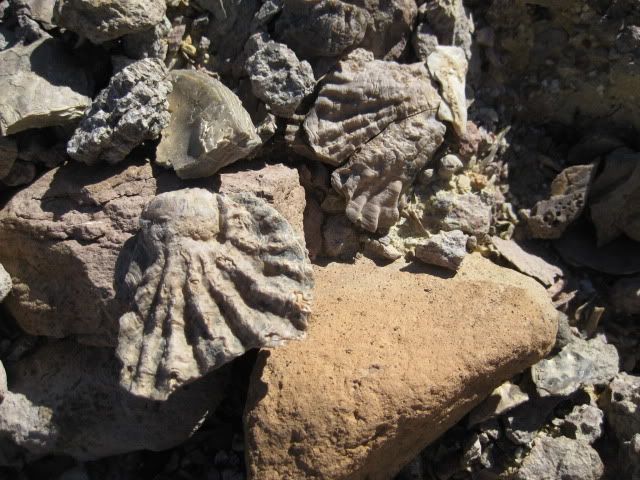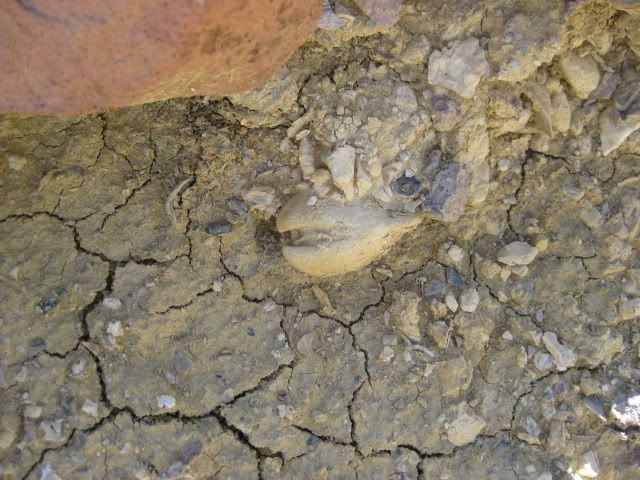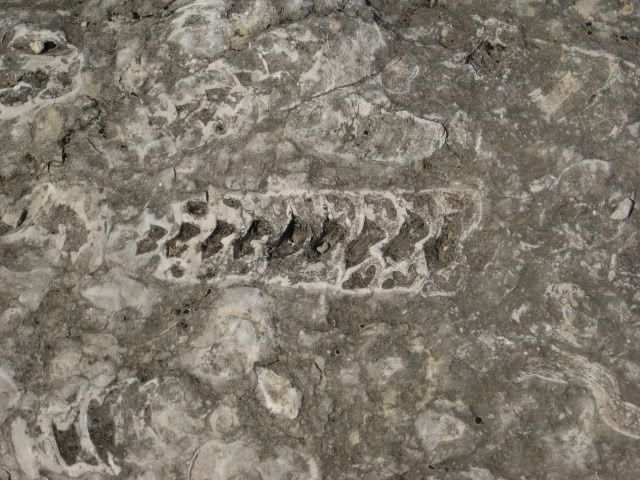| Pages:
1
2
3
4 |
David K
Honored Nomad
        
Posts: 65109
Registered: 8-30-2002
Location: San Diego County
Member Is Offline
Mood: Have Baja Fever
|
|
How old are the fossils in Baja?
I have been spending a long time on Google search.... and it's worn me out! LOL
Would someone in-the-know... know?
I welcome anyone with some geology or rock-hound expertise!
I have seen fossils at El Rosario, Las Pintas, south of San Felipe, near Bahia Asuncion, and, well lots of places. Either they are several miles from
the beach or hundreds of feet above sea level, or both!
How old are the fossil shells, sharks teeth, and other items turned to rock we see in Baja?
Is the location where we see these fossil sea shells and teeth that was once under the water indicate a far higher sea level, tectonic tilting of the
land up and out of the ocean, or both?
I realize that the fossil beds in different area might come from different geologic periods... or are they from the same period being that the
peninsula is a pretty narrow sliver of land compared to the size of the earth?
Thanks for your input!



|
|
|
Cisco
Ultra Nomad
    
Posts: 4196
Registered: 12-30-2010
Member Is Offline
|
|
| Quote: | Originally posted by David K
I have been spending a long time on Google search.... and it's worn me out! LOL
Would someone in-the-know... know?
I welcome anyone with some geology or rock-hound expertise!
I have seen fossils at El Rosario, Las Pintas, south of San Felipe, near Bahia Asuncion, and, well lots of places. Either they are several miles from
the beach or hundreds of feet above sea level, or both!
How old are the fossil shells, sharks teeth, and other items turned to rock we see in Baja?
Is the location where we see these fossil sea shells and teeth that was once under the water indicate a far higher sea level, tectonic tilting of the
land up and out of the ocean, or both?
I realize that the fossil beds in different area might come from different geologic periods... or are they from the same period being that the
peninsula is a pretty narrow sliver of land compared to the size of the earth?
Thanks for your input!


 |
At the San Diego Natural History Museum they have a really nice plate tectonics display that shows the movement of Baja (and the rest of the world)
over time. Projections of future movement and some of the uplifting that has occurred on a large-scale vs the computer screen.
As a San Diego resident it's free (ALWAYS was free before) the first Tuesday of the month and they have nice and knowledgeable docents that could be
of help also.
Fascinating question.
|
|
|
bajadogs
Super Nomad
   
Posts: 1069
Registered: 8-28-2006
Member Is Offline
|
|
The Natural History Museum in Balboa Park has a wonderful display of local San Diego fossils and Baja fossils. I have seen cliffs of seashell fossils
similar to pic #2. The ones that are also similar on display at the museum were found in the same area I saw these cliffs and are estimated to be 26
million years old. Don't bother asking me where.
|
|
|
David K
Honored Nomad
        
Posts: 65109
Registered: 8-30-2002
Location: San Diego County
Member Is Offline
Mood: Have Baja Fever
|
|
I just thumbed through the Roadside Geology book, and didn't spot any ages... I used to camp and explore the fossil oyster beds in the Imperial Valley
(Yuha Desert)... Here is what a BLM paper says:
Visitors along the road may see evidence of this time period through
an abundance of exposed fossilized oysters and barnacles. Dating from the late Miocene Epoch, these six million year old fossils are part of the
Imperial Formation and can be collected in limited quantities for personal use.
|
|
|
capt. mike
Elite Nomad
     
Posts: 8085
Registered: 11-26-2002
Location: Bat Cave
Member Is Offline
Mood: Sling time!
|
|
i think the oldest fossils in baja can be found at trailer parks around 6 mos a year....... ;^))
formerly Ordained in Rev. Ewing\'s Church by Mail - busted on tax fraud.......
Now joined L. Ron Hoover\'s church of Appliantology
\"Remember there is a big difference between kneeling down and bending over....\"
www.facebook.com/michael.l.goering |
|
|
chuckie
Elite Nomad
     
Posts: 6082
Registered: 2-20-2012
Location: Kansas Prairies
Member Is Offline
Mood: Weary
|
|
I am almost 80, if that helps...
|
|
|
dirtbikr
Junior Nomad

Posts: 72
Registered: 11-1-2011
Location: sacramento
Member Is Offline
Mood: start slow....then taper off!
|
|
Wait a minite, the bible says the earth is six thousand years old, lol
If you\'re not living on the EDGE... You\'re taking up too much room! Its never too late for a darkside.
|
|
|
DENNIS
Platinum Nomad
       
Posts: 29510
Registered: 9-2-2006
Location: Punta Banda
Member Is Offline
|
|
I used to date a fossil who was older than dirt. 
|
|
|
wessongroup
Platinum Nomad
       
Posts: 21152
Registered: 8-9-2009
Location: Mission Viejo
Member Is Offline
Mood: Suicide Hot line ... please hold
|
|
You're up and running today  
[Edited on 2-16-2013 by wessongroup]
|
|
|
David K
Honored Nomad
        
Posts: 65109
Registered: 8-30-2002
Location: San Diego County
Member Is Offline
Mood: Have Baja Fever
|
|
When I said I need "fossil dating", I wasn't speaking of eHarmony.old!  
|
|
|
David K
Honored Nomad
        
Posts: 65109
Registered: 8-30-2002
Location: San Diego County
Member Is Offline
Mood: Have Baja Fever
|
|
Good link... the gulf 'opened up' 4 million years ago
A Hypothesis as to the Origin of the Gulf of California
The Baja peninsula, including most of southwestern California is an elongated slab of the North American continent that has been sheared from the
mainland and moved to its present position.
The postulated movement of the peninsula may be retraced backward in time and in direction. Looking back to the Cretaceous, the peninsula is brought
into a likely former position with the mainland. In this arrangement, the Sierra Madre del Sur appears to continue without break from mainland Mexico
into Baja California.
In Pliocene time, about seven million years ago, a zone of separation developed on the East Pacific Rise. The future Baja California peninsula and a
piece of future California were sheared from mainland Mexico along a lateral fault, possibly the ancestral San Andreas fault which was then, as now,
oriented northwest-southeast. During this early period of development, movement was right lateral, with the sheared-off slab moving northwest, but
always in close contact with the mainland.[1]
The northwest movement seems to have been repeated slippage along the principal members of the San Andreas fault system -- the Elsinore fault, the San
Jacinto fault, and the main San Andreas strand itself.
About four million years ago, the San Andreas fault proceeded to play a key role in the next phase, the opening of the mouth of the Gulf of
California. While the Baja California peninsula continued to move to the northwest as a whole, its southern end began to rotate westward, opening a
seaway between the new peninsula and the mainland.
This movement is thought to have been caused by torsional stress. That is, while the primary movement continued to be northwest, the northern end of
the Baja California peninsula became locked against the mainland, causing the southern end to rotate westward, creating the seaway that was to become
the Gulf of California.
As the Gulf continued to open, Baja California moved out to sea while the Peninsular Ranges of California remained attached to the mainland block.
Movement along the San Andreas fault system was vigorous, and the San Jacinto fault became the most active member. At this time, the San Jacinto
Mountains and the Santa Rosa Mountains were sharply compressed and uplifted.
Like a massive lever, the rotation caused intense compression forces at the north end, near the fulcrum. The squeezing effect helped to raise the
Transverse Ranges of the Los Angeles basin (the Santa Monica, San Gabriel and San Bernardino Mountains), orienting them east-west, as opposed to the
northwest-southeast direction of other major ranges of central and southern California.
Coincident with these forces, there were stresses that formed the offshore basins, such as the Santa Barbara Channel and the underwater grabens off
the southern California coastline.
It thus appears that the East Pacific Rise extends well into the Gulf of California and sea floor spreading is widening the Gulf. Tensional thinning
at the spreading center between the North American plate and the Pacific plate is further supported by the existence of a large intrusion of magma
beneath the sediments of the Salton Sea. The result is regional metamorphism of the sedimentary fill beneath the Salton Sea, resulting in high heat
flow and the geothermal activity and volcanism in the Imperial Valley.
(above from http://www.sci.sdsu.edu/salton/The%20Gulf%20of%20California.... )
|
|
|
mtgoat666
Select Nomad
      
Posts: 19373
Registered: 9-16-2006
Location: San Diego
Member Is Offline
Mood: Hot n spicy
|
|
| Quote: | Originally posted by David K
How old are the fossils in Baja? |
fossils tell a story about tectonics and climate change. you have told us repeatedly that climate science is a pack of lies, assume you would dismiss
any paleontology we share with you here same as you dismiss paleontology when it's part of climate change studies,...
p.s. the answer is: many different ages; and older than dirt  
|
|
|
BajaBlanca
Select Nomad
      
Posts: 13212
Registered: 10-28-2008
Location: La Bocana, BCS
Member Is Offline
|
|
Oh boy, I sure hope someone pipes up to offer some insight as to possible ages of fossils. This is a MOST fascinating topic.
There is a mountain, far away from the ocean, and not even too close to us, that is full of fossils esp shark teeth. no other mountain in the
vicinity has them, and the desert terrain around doesn't either. very fascinating indeed.
recently, islandbuilder's wife showed me her new version of THE BAJA HIGHWAY book which was updated by one of the author's kids. I need one... I
love my old one and have read it many a time while going up and down the coast. It shows the signs of multiple readings in a vehicle !
|
|
|
Bwana_John
Nomad
 
Posts: 291
Registered: 10-17-2007
Member Is Offline
|
|
Fossils usually correspond to the age of rock they are found in (although they can be older).
Fossils usually require an environment of sedimentary deposition to be preserved, igneous and metamorphic processes tend to destroy fossils.
The rock type indicates the environment of deposition (ie limestone's-shallow tropical seas, shale's- nearshore continental setting, tuff's- ashfall,
ect...)
The peninsula is comprised of many types and ages of rock, and many types and ages of fossils.
Many of the rocks and fossils were not deposited at the same latitude and longitude as present Baja. They were deposited in many different
environments and tectonic regimes.
Current uplifts have exposed the rocks and fossils to erosion, so that they can now be found at the surface.
The earth is VERY old, and very dynamic. So much so that "Geologic Time" can be a hard concept to comprehend.
|
|
|
windgrrl
Super Nomad
   
Posts: 1336
Registered: 9-2-2006
Member Is Offline
|
|
Key word: zoology?
This site looks promising...just trying to figure out how to use it:
The Online Books page
Now then, if the universe has an "infinite past with no beginning" http://en.wikipedia.org/wiki/Time then one could just enjoy being in the same moment with one's discoveries.
Living in the present,
W

When the way comes to an end, then change. Having changed, you pass through.
~ I-Ching
|
|
|
BajaRat
Super Nomad
   
Posts: 1303
Registered: 3-2-2010
Location: SW Four Corners / Bahia Asuncion BCS
Member Is Offline
Mood: Ready for some salt water with my Tecate
|
|
just talked to my 7 year old daughter,
amonites are dated from early Devonian to cretaceous period, or 400 to 65.5 million years ago. She identified some other Baja fossils but I can't
spell them. when I get home I'll have her spell them with aprox dates.
P.S. She didn't learn that in school..... It's her bag.
[Edited on 2-17-2013 by BajaRat]
|
|
|
windgrrl
Super Nomad
   
Posts: 1336
Registered: 9-2-2006
Member Is Offline
|
|
Good info....
http://babel.hathitrust.org/cgi/pt?id=mdp.39015068331860;ski...
...identifies and describes observations of geological periods.
When the way comes to an end, then change. Having changed, you pass through.
~ I-Ching
|
|
|
wilderone
Ultra Nomad
    
Posts: 3856
Registered: 2-9-2004
Member Is Offline
|
|
This report says about 8.6 million years for the shells around Bahia Asuncion.
Kinda technical report but fascinating. I would assume some of the dating could be applied to other areas of Baja CA. I've read elsewhere that, e.g.,
the geography around Punta Baja, has not shifted too much. Not too far inland would be estuary - where you can now find tree and dinosaur fossils (so
not underwater as a seabed).
http://satori.geociencias.unam.mx/11-2/(11)Moreno.pdf
[Edited on 2-17-2013 by BajaNomad]
|
|
|
BajaLucy
Junior Nomad

Posts: 61
Registered: 12-6-2012
Location: Some place around Baja
Member Is Offline
Mood: {BajaTime}
|
|
Thanks for an interesting topic. Keep us posted from any incoming News I want to learn more and I bet many other Baja lovers too thank you, 
|
|
|
Pompano
Elite Nomad
     
Posts: 8194
Registered: 11-14-2004
Location: Bay of Conception and Up North
Member Is Offline
Mood: Optimistic
|
|
Baja Fossils.
I have some great camcorder movies of some fossilized shell beds we found long ago on one of the old trails into Pta. Chivato. If I can master the
how-to-do-it of video 'uplink'?, I'll try posting it on Nomads.
Also to do with fossils, a couple years ago, a buddy found a very large shark tooth in an arroyo near an East Cape beach. Megladon, a big brute. In
the next photo, I am holding a normal-sized, present-day shark tooth.
From Wikipedia and for what it's worth, The most commonly found fossil shark's teeth 'worldwide' are from the Cenozoic (the last 65 million years).

p.s. Thanks to Skipjack Joe for the 'Jaws' movie photo. "This one will take 4 barrels.."
[Edited on 2-17-2013 by Pompano]
[Edited on 2-18-2013 by BajaNomad]
I do what the voices in my tackle box tell me.
|
|
|
| Pages:
1
2
3
4 |

